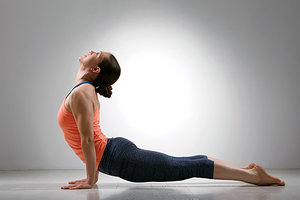"Doctor, can I continue to do yoga while undergoing your care?" "Is it OK for me to go back to yoga while I'm getting my back treated?" "It is safe to start my yoga classes again after my neck pain improves?" If you're like me, these are some of the questions patients have been presenting with over the years.
Because so many people / patients may be participating in yoga, it's important to understand the literature when it comes to its effectiveness and safety. Let's examine some of this research so you can be prepared to communicate effectively with your patients, whether you're looking to refer out or just provide them with the right message when recommending yoga as a service.
Yoga 101: Origins, Utilization, Etc.
Yoga is a form of exercise and deep breathing with origins in India. There are a wide variety of different styles of yoga, each focusing on specific goals and programs. Programs can focus on structure (Iyengar yoga) with the use of blocks and straps, to meditation and breathing (kundalini yoga). Although addressing each style of yoga is beyond the scope of this article, we'll reference them if the information relates to a specific style.
 Participation in yoga is increasing. Holden, et al. (2015), found one-third of all women used complementary and alternative medicine during pregnancy and childbearing years, but only half disclosed CAM to their health care providers.2 Thirteen percent of pregnant women and 16 percent of nonpregnant women used yoga.
Participation in yoga is increasing. Holden, et al. (2015), found one-third of all women used complementary and alternative medicine during pregnancy and childbearing years, but only half disclosed CAM to their health care providers.2 Thirteen percent of pregnant women and 16 percent of nonpregnant women used yoga.
A recent National Health Statistics Report revealed yoga use increased across three time points from 2002 to 2007 to 2012 (5.1 percent, 6.1 percent and 9.5 percent, respectively).3 The highest prevalence of use across all three time points was by adults between the ages of 18 and 44.
Patients may also be self-prescribing their own treatments with yoga prior to seeing you. In a study of women 60 to 65 years of age, Murthy V, et al. (2014), found that 75.2 percent of women self-prescribed one or more CAM therapies for back pain. Yoga and meditation accounted for 14.3 percent of use.4
Injuries related to yoga are infrequent, although the number of reported injuries is increasing due to increased use. A recent study by Russell K, et al. (2015), found the most common type of injury was a sprain (34 percent) and the most likely area was the lower extremity (42 percent).5 Severe injury is also quite rare. Holton MK, et al. (2014), found less than 1 percent of individuals who practiced yoga reported an injury that led to discontinued use.6 A recent systematic review and meta-analysis of randomized, controlled trials came to the same conclusion. Cramer H, et al. (2015), concluded yoga appears to be as safe as usual care and exercise.7
The Benefits of Yoga for Musculoskeletal Complaints
Research suggests yoga may be effective for a wide variety of conditions, such as arthritis, chronic low back pain, fibromyalgia and balance in the elderly. However, a note of caution about research findings: A study by Cramer H, et al. (2015), found that "RCTs on yoga that are conducted in India have about 25 times the odds of reaching positive conclusions as those conducted elsewhere."8 Let's take a look at some of the most recent findings.
Low Back Pain: A systematic review by Crow, et al. (2015), found there was strong evidence for the short-term effectiveness for yoga.9 However, there was little evidence for long-term effectiveness for chronic spine pain. The type of yoga reviewed in this study was the Iyengar yoga method.
Iyengar yoga also was examined in a randomized, controlled study by Nambi GS, et al. (2014). They compared yoga therapy to conventional exercise therapy on pain intensity and health-related quality of life in subjects with nonspecific, chronic low back pain. Results showed Iyengar yoga provides better improvements in pain reduction and improvement in health-related quality-of-life measurements.10
Muscle Activation: If your patients require core muscle activation and are participating in yoga, a recent study by Ni M, et. al. (2014), sheds some light on muscle function during various poses.11 "High plank," "low plank" and "downward facing dog" were effective for strengthening the external oblique abdominis. "Chair" and "warrior 1" poses were useful for the gluteus maximus, and chair and "halfway lift" poses were effective for strengthening the longissimus thoracis. The "upward facing dog" pose can be used to strengthen all three muscles.
Elderly Balance: Although a Cochrane Review (2012) didn't find any evidence of improvements in balance, newer studies seem to show some benefits.12 In a study by Nick N, et al. (2015), an intervention group performed yoga two times per week for eight weeks. Compared to controls, the yoga group had significant improvements in the Modified Falls Efficacy Scale and the Berg Balance Scale.13
Saravanakumar P, et. al. (2014), looked at the impact of tai chi and yoga on balance and falls in residential care settings. Yoga participation was associated with a slight decrease in fall incidence and average pain scores, although results were not statistically significant.14
Arthritis: Although the average yoga user is younger than older, yoga may be beneficial for those with arthritis. A recent study by Moonaz SH, et al. (2015), assessed integral-based hatha yoga in sedentary people with arthritis. Preliminary evidence suggested yoga can be practiced safely and improves physical and psychological health, including health-related quality of life.15 Ghasemi GA, et al. (2013), also found yoga significantly reduced pain and symptoms in a group of women with osteoarthritis.16
Which yoga exercises provide the best muscle activation for knee strengthening in patients with osteoarthritis? Longpre HS, et al. (2015), assessed various yoga postures, finding quadriceps activation was highest during the squat and lunge postures, producing more co-contraction indices than other postures. The wide-legged squat ("goddess") and lunge with trunk upright ("warrior") poses produced the lowest knee adduction moments, which may benefit those with knee osteoarthritis.17
Although your patients may continue with their yoga exercises, yoga adherence should be monitored with follow-up visits. Cheung C, et al. (2015), found many participants adhered to yoga practice six months post-osteoarthritis intervention.18 Feeling better and practice motivated the participants. However, dealing with health problems (42 percent), experiencing pain (25 percent) and being too busy (25 percent) were the major barriers to continuation.
Flexibility: For flexibility training, yoga was shown to be more effective than calisthenics. Farinatti PT, et al. (2014), used hatha yoga for the study, which features slow, passive movements.19
Spinal flexibility is also shown to improve with yoga use. Grabara M, et al. (2015), assessed the effects of hatha yoga for women older than age 50. Results demonstrated not only increased hamstring flexibility, but also overall spinal flexibility.20
Practice Applications
As more of your patients take up yoga, it's important for chiropractors to have at least a beginner's knowledge of its effects on various musculoskeletal conditions. Yoga features numerous variations, so it's important to identify which one your patient is doing. Iyengar yoga appears to be effective for low back pain, while hatha yoga can be used for flexibility and arthritis.
Various yoga poses also influence muscle activation. A working knowledge can be helpful when assessing a patient's current yoga poses and how they are impacting their condition / your treatment.
If your patient asks you about starting yoga, there are several different organizations to which you can refer them. The International Association of Yoga Therapists (IAYT) and the Yoga Alliance both offer online search tools to provide a qualified yoga practitioner in your community. Although not all-inclusive, this is a good list to begin with, especially the next time your patient asks for your advice on yoga.
A final note: As more chiropractors look to provide services to their patients beyond spinal manipulation, you may want to consider adding yoga as a practice service. If so, this conversation may be your starting point to understand the type of yoga that may be beneficial to your patient population.
References
- "Yoga Journal Releases 2012 Yoga in America Market Study." Press release by the Yoga Journal, Dec. 6, 2012.
- Holden SC, et al. Complementary and alternative medicine use among women during pregnancy and childbearing years. Birth, 2015;
- National Health Statistics Report: www.cdc.gov/nchs/data/nhsr/nhsr079.pdf.
- Murthy V, et al. Self-prescribed complementary and alternative medicine use for back pain amongst a range of care options: results from a nationally representative sample of 1310 women aged 60-65 years. Complement Ther Med, Feb 2014;22(1):133-40.
- Russell K, et al. Epidemiology of yoga-related injuries in Canada from 1991 to 2010: a case series study. Int J Inj Contr Saf Promot, May 8, 2015:1-7.
- Holton MK, et al. Do side-effects / injuries from yoga practice result in discontinued use? Results of a national survey. Int J Yoga, Jul 2014;7(2):152-4.
- Cramer H, et al. The safety of yoga: a systematic review and meta-analysis of randomized controlled trials. Am J Epidemiol, Jun 26, 2015;
- Cramer H, et al. Are Indian yoga trials more likely to be positive than those from other countries? A systematic review of randomized controlled trials. Contemp Clin Trials, Mar 2015;41:269-72.
- Crow EM, et al. Effectiveness of Iyengar yoga in treating spinal (back and neck) pain: a systematic review. Int J Yoga, Jan 2015;8(1):3-14.
- Nambi GS, et al. Changes in pain intensity and health related quality of life with Iyengar yoga in nonspecific chronic low back pain: a randomized controlled study. Int J Yoga, Jan 2014;7(1):48-53.
- Ni M, et al. Core muscle function during specific yoga poses. Complement Ther Med, Apr 2014;22(2):235-43.
- Howe TE, Rochester L, Neil F, et al. Exercise for improving balance in older people. Cochrane Database Syst Rev, Nov 9, 2011;(11).
- Nick N, et al. The effect of yoga on balance and fear of falling in older adults. PM & R, Jul 8, 2015 (epub ahead of print).
- Saravanakumar P, et al. The influence of tai chi and yoga on balance and falls in a residential care setting: a randomized controlled trial. Contemp Nurse, 2014;48(1):76-87.
- Moonaz SH, et al. Yoga in sedentary adults with arthritis: effects of a randomized controlled pragmatic trial. J Rheumatol, Jul 2015;42(7):1194-202.
- Ghasemi GA, et al. Effects of hata yoga on knee osteoarthritis. Int J Prev Med, Apr 2013;4(Suppl 1):S133-8.
- Longpre HS, et al. Identifying yoga-based knee strengthening exercises using the knee adduction moment. Clin Biomech, Jun 16, 2015 (epub ahead of print).
- Cheung C, et al. Yoga adherence in older women six months post-osteoarthritis intervention. Global Adv Health Med, May 2015;4(3):16-23.
- Farinatti PT, et al. Flexibility of the elderly after one-year practice of yoga and calisthenics. Int J Yoga Ther, Sep 2014;24:71-77.
- Grabara M, et al. Effects of hatha yoga exercises on spine flexibility in women over 50�years old. 2015 Feb;27(2):361-5.
Click here for previous articles by Jasper Sidhu, BSc, DC.





